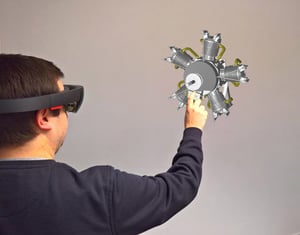
Augmented reality in mechanical engineering service | 5 reasons why AR is the future of visual support
Discover how augmented reality is revolutionizing service in mechanical engineering and why AR is considered an indispensable tool for the future.
Augmented reality in mechanical engineering service | 5 reasons why AR is the future of visual support
The role of augmented reality in modern remote service
Augmented reality (AR) is playing an increasingly important role in modern mechanical engineering and its after-sales service. The use of AR can lead to considerable cost savings. On the one hand, travel costs are reduced as experts no longer need to be physically on site to provide technical support. On the other hand, expensive production downtime can be avoided thanks to faster and more precise troubleshooting.
By integrating digital information into the real world, AR enables technicians to carry out complex maintenance tasks remotely. This is achieved through the use of AR glasses or mobile devices that project visual instructions and real-time data directly into the user's field of vision.
This technology makes it possible to enrich the physical environment with digital overlays, which significantly improves the comprehensibility and precision of maintenance instructions. This not only increases the quality of remote maintenance, but also shortens the learning curve for new technicians.
1. real-time overlays of instructions
AR makes it possible to superimpose visual instructions directly over the real object the technician is working on. This results in more precise and intuitive instructions, as the technician can see exactly which components they need to work on. Visual aids such as 3D models, interactive diagrams and real-time video circuits help to better understand sources of error and implement the necessary corrective measures more efficiently. This leads to a significant improvement in diagnostic speed and accuracy.
2. efficient training and knowledge transfer
AR can make training more efficient by training technicians in a simulated but realistic environment. In addition, less experienced technicians can be instructed by experienced colleagues who give detailed instructions via the AR solution without being physically present.
3. increasing efficiency and reducing downtime
One of the biggest challenges in industry is minimizing downtime. AR can make a decisive contribution here by enabling technicians to work faster and more effectively. With AR, they can get immediate access to detailed instructions and real-time support without having to wait for external specialists with experts.
With the immediate availability of information and the ability to visually support complex maintenance procedures, repairs and maintenance work can be completed much faster. This not only reduces downtime, but also increases overall productivity.
4. cost savings through AR-supported maintenance procedures
In addition, AR-based training and training programs enable more efficient onboarding of new employees, which reduces personnel costs in the long term. Overall, AR technology helps to optimize operating costs and increase profitability.
5 Real-time communication: How visual tools speed up troubleshooting
The implementation of AR in maintenance services can lead to significant cost savings. On the one hand, travel costs are reduced as experts no longer need to be physically on site to provide technical support. On the other hand, faster and more precise troubleshooting can avoid expensive production downtime.
6 Increased safety
AR can increase the safety of technicians by visualizing and warning of risks before potentially dangerous actions are taken. Technicians thus receive an additional layer of safety information that is updated in real time.
Future prospects and further development of AR technology in industry
The future of AR technology in industry looks promising. With continuous advances in hardware and software, AR is becoming more powerful and accessible. Future developments could include: improved user interfaces, enhanced sensor integration and even more precise real-time analytics.
In addition, new applications and industries could benefit from this technology, leading to wider adoption and implementation. The combination of AR with other emerging technologies such as Artificial Intelligence (AI) and the Internet of Things (IoT) could further push the boundaries of remote maintenance and open up completely new possibilities.




